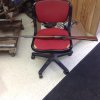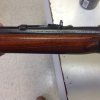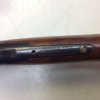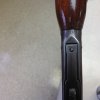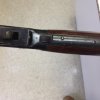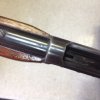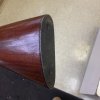so a customer came into my shop with what he thought a very valuable rifle. A Winchester 1894 made in 1911-1912 chambered in 25-35. However, the barrel is marked model 64. From what my Winchester book says the model 64 wasn't started until 1933 (It has been a couple days since I looked it up so I could be off on that date slightly). So I have a Winchester rifle with an 1894 receiver, a model 64 barrel/magazine tube and model 64 furniture. I took some pictures if everyone shouts enough to want and see it. However, my question is has anyone heard of this kind of modification being done before? And if it was professionally done, is there any concerns about it being safe to shoot? Any information anyone has to offer is welcome. Thank you!
You are using an out of date browser. It may not display this or other websites correctly.
You should upgrade or use an alternative browser.
You should upgrade or use an alternative browser.
Winchester 1894 receiver and 64 barrel
- Thread starter DASHMAN77
- Start date
- Status
-
Not open for further replies.
CraigC
Sixgun Nut
I'm not surprised, as the 64 configuration is probably the most practical and well-balanced of the bunch. As long as the gun passes inspection and does not have excessive headspace, I wouldn't hesitate to shoot it.
entropy
Member
PICS!!!!
Such modifications aren't that unusual. Its likely the result of a poor original barrel, rusted or pitted, and replaced with either the choice of the owner, or whatever may have been available to the local gunsmith, or a factory job.
Value is not great, certainly less than whatever it would have been with its original barrel. Its still a shooter, just not as valuable as if in original condition.
The barrel should have a date on the bottom of it under the fore end. If it can be taken apart, you can get a date the barrel was made.
Value is not great, certainly less than whatever it would have been with its original barrel. Its still a shooter, just not as valuable as if in original condition.
The barrel should have a date on the bottom of it under the fore end. If it can be taken apart, you can get a date the barrel was made.
Thank you for the input. Everything looks really well done and on the surface looks good to go. And pictures are for those who can offer useable information but need a visual to do so, sorry.I'm not surprised, as the 64 configuration is probably the most practical and well-balanced of the bunch. As long as the gun passes inspection and does not have excessive headspace, I wouldn't hesitate to shoot it.
Yeah I told him the value was now in it being a shooter and no longer a collectable. Thank you for the barrel dating info! That's exactly the information I need. He wants to know more about the rifle and all I could do was dash his hopes of a pay day and that it's a Frankenstein. LolSuch modifications aren't that unusual. Its likely the result of a poor original barrel, rusted or pitted, and replaced with either the choice of the owner, or whatever may have been available to the local gunsmith, or a factory job.
Value is not great, certainly less than whatever it would have been with its original barrel. Its still a shooter, just not as valuable as if in original condition.
The barrel should have a date on the bottom of it under the fore end. If it can be taken apart, you can get a date the barrel was made.
If you have a copy of Madis' The Winchester Book, it may have other info such as what styles of stampings were used at different times on the barrels, but the date on the bottom is the simplest.
Does it have the old straight grip stock or has it been changed to the pistol grip and shotgun butt of the model 64?
Does it have the old straight grip stock or has it been changed to the pistol grip and shotgun butt of the model 64?
It is the old straight style. My Winchester book is just a little hand book that gives serial number/ manufacturer date ranges. I tried to get the forend off with no luck. I can't get it to slide forward enough to come out of the grooves from the receiver. It hits a piece of metal the forend band screws into. So I can't see the date of the barrel.
It is the old straight style. My Winchester book is just a little hand book that gives serial number/ manufacturer date ranges. I tried to get the forend off with no luck. I can't get it to slide forward enough to come out of the grooves from the receiver. It hits a piece of metal the forend band screws into. So I can't see the date of the barrel.
The entire magazine and forend has to come off.
Remove the magazine end cap (cross)screw. --> Be advised the cap is under spring pressure from the magazine spring, it has to be controlled as the cross screw is removed. Remove cap (it does not thread into the tube, despite having a screwdriver slot in its end. The purpose of the slot is either an intelligence test or is to tempt people to try to unscrew it and have to buy parts to replace the one they ruined. Truly, the caps/tubes werent threaded in since the 1870s.). Cap probably has small extension that engages a slot in the underside of the barrel, it needs to be turned enough to disengage the slot. Remove spring,
Remove forend cap screws (2), slide cap forward. Magazine ring, if it has a cross pin, needs to have the pin drifted out. If no pin, magazine tube should slide forward. It has to come completely out of the forend for the forend to be removed. If you twist it it may end up with zig-zag scratches on the tube. Oil it if needed to facilitate removal, they often are sticky or gummy or encrusted in place with old oil. If desired to remove the magazine ring for any reason, it rotates in its dovetail, it does NOT drift sideways like a sight. Many are ruined when some goob tries to drive them out sideways with a hammer and punch.
Once magazine tube is removed, the forend can tip downward at the front to clear the forend cap tennon then come out of its recess in the front of the receiver. Youll see that it cant come out without removing the magazine tube due to its being a machined snug fit around the tube. Once assembled though, they are pretty durable due to not being hollowed out.
Barrel date should be a 2 digit number stamped on the bottom of the barrel along with caliber and inspection marks.
So long as the tube isn't too crusty, they come apart fairly easily.
At one time Numrich Arms sold I think model 64 barrels as replacements for 94's so shooters could replace worn out barrels
Winchester also sold them direct, and the older Shooters Bible books sold parts directly for all types of guns. I was just looking at one from 1944 I believe, it had quite a few Winchester barrels listed, from model 94s, rifles, carbines, takedowns etc in all sorts of calibers, model 55s, model 64s, model 92s, model 53s, model 71s.
I don't know if it played any real part in decision making, but during the wartime years (WWII), there was ammunition rationing to civilians. I don't recall the details, but 30-30 and 30-06 were some of the most available by rounds per month allowed to be bought during the war. If others were harder to get, it may have been one reason some guns were rebarreled with later barrels if they were different chamberings originally.
If 30-30 was the most available that would be weird they would change to a different caliber but since the 25-35 uses the same case(correct me if I'm wrong, it's what I was told and read the 25-35 was based on the 30/30 case) maybe he modified 30-30 ammo to make 25-35. But that's a question for the ages. I greatly appreciate all the info. I was afraid I was going to have to take more apart beside the barrel band to get the forearm off. It was so close too. Slight notching in the forend wood, would allow me to slip past the receiver channel and get it off its that close. However, I know better. When I get to work Tuesday I will follow your instructions and get it off. I'm curious to know now myself. As for the markings, I will look through the photos I took and try and remember how to load them on the site. It's been awhile since I've been on the forum and things look different. Thank you again for all the information. Love THR. I have questions the folks on THR have answers. And thank you malamute.
Interesting that it doesn't have the typical rifle type crescent butt plate, but looks like more of a shotgun type butt, similar to what was common on carbines after the early 30s. May be a model 55 butt also. Is the comb fluted? What does the butt plate look like?
Not a bad looking old gun as a shooter.
Two different proof marks on the barrel, not sure what the extra one means. Extra is closest to the receiver.
Not a bad looking old gun as a shooter.
Two different proof marks on the barrel, not sure what the extra one means. Extra is closest to the receiver.
Last edited:
Buttplate looks like typical 1950s/early 60s standard carbine. I dont know when they first started using the checkered butt plates, I thought the firstshotgun type butts on carbines from the 30s had grooved plates, but I may be wrong, or the plate on the gun may have been changed at some point. If the inletting fits the upper tang by the sides of the hammer, then its a pre-war stock in any event. The stock was changed after the war and remained the same into the post 64 production.
If it was 64 buttstock, it would be a tight pistol grip stock, lower tang and lever. Its likely a standard carbine butt from a later gun than the receiver. I asked about the comb being fluted, wondering if maybe it was a 55 stock. I think(?) that the 55s had fluted combs, but carbines never have that I know of. Not positive, but I think the 55s all had the lined or grooved butt plate rather than the checkered one without the diamonds around the screw holes. 64s had a checkered butt plate with non-checkered border and an uncheckered diamond around the screw holes, and most had the small nub on top front edge of the butt plate going forward from the top edge of the plate. Very small, not like the what rifles have an upper tang with screw type thing. Early 1900srifles with shotgun butts also had the same type buttplate with the diamonds around the screw holes etc, clear back I believe into at least the 1886 rifles with shotgun butts. Older Model 70s had pretty much identical type butt plates.
Sorry for all the editing, I remember more stuff, and keep seeing things my junky computer keyboard didnt type well. It has several messed up keys.
If it was 64 buttstock, it would be a tight pistol grip stock, lower tang and lever. Its likely a standard carbine butt from a later gun than the receiver. I asked about the comb being fluted, wondering if maybe it was a 55 stock. I think(?) that the 55s had fluted combs, but carbines never have that I know of. Not positive, but I think the 55s all had the lined or grooved butt plate rather than the checkered one without the diamonds around the screw holes. 64s had a checkered butt plate with non-checkered border and an uncheckered diamond around the screw holes, and most had the small nub on top front edge of the butt plate going forward from the top edge of the plate. Very small, not like the what rifles have an upper tang with screw type thing. Early 1900srifles with shotgun butts also had the same type buttplate with the diamonds around the screw holes etc, clear back I believe into at least the 1886 rifles with shotgun butts. Older Model 70s had pretty much identical type butt plates.
Sorry for all the editing, I remember more stuff, and keep seeing things my junky computer keyboard didnt type well. It has several messed up keys.
Last edited:
- Status
-
Not open for further replies.
Similar threads
- Replies
- 8
- Views
- 1K
- Replies
- 70
- Views
- 19K


